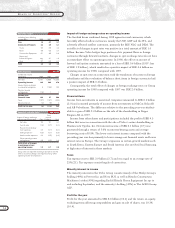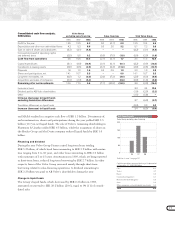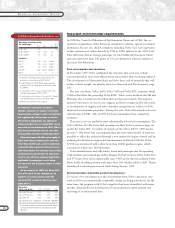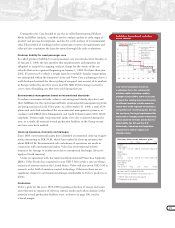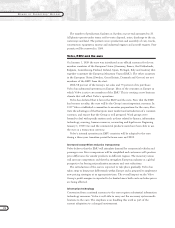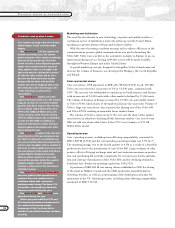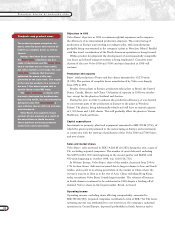Volvo 1998 Annual Report Download - page 24
Download and view the complete annual report
Please find page 24 of the 1998 Volvo annual report below. You can navigate through the pages in the report by either clicking on the pages listed below, or by using the keyword search tool below to find specific information within the annual report.
22
The number of production facilities in Sweden at year-end amounted to 23.
All plants operate under terms set for waste disposal, noise, discharge to the air,
waterways and land. The permit covers production and assembly of cars, trucks,
construction equipment, marine and industrial engines and aircraft engines. Four
permits will be renewed in 1999.
Volvo, EMU and the euro
On January 1, 1999 the euro was introduced as an official currency for eleven
member countries of the European Union (Germany, France, the Netherlands,
Belgium, Luxembourg, Finland, Ireland, Spain, Portugal, Italy and Austria) that
together constitute the European Monetary Union (EMU). The other countries
in the European Union (Sweden, Great Britain, Denmark and Greece) are not
members of the EMU from the start.
With 58 percent of the Group’s net sales and 75 percent of its purchases
Volvo has substantial operations in Europe. Most of the countries in Europe in
which Volvo is active are members of the EMU. This is creating a new business
climate that will affect Volvo’s operations.
Volvo has declared that it favors the EMU and the euro. Now that the EMU
has become a reality, the euro will be the Group’s most important currency. In
1997 Volvo established a committee to monitor preparations for the euro, illus-
trate the advantages of the European inner market and introduction of a common
currency, and ensure that the Group is well prepared. Work groups were
formed to deal with specific matters such as those related to finance, information
technology, sourcing, human resources, accounting and legal issues. Beginning
January 1, 1999 Cars and the commercial products units have been able to use
the euro as a transaction currency.
Volvo’s internal operations in EMU countries will be adapted to the euro
during a three-year transition period between now and 2002.
Increased competition and price transparency
Volvo believes that the EMU will stimulate demand for commercial vehicles and
passenger cars. Price comparisons will be simplified and customers will question
price differences for similar products in different regions. The monetary union
will increase competition and thereby strengthen European industry in a global
perspective by forcing rationalization measures and cost reductions.
The introduction of the euro is expected to take place gradually. Volvo has
taken steps to limit price differentials within Europe and is prepared to implement
new pricing strategies at an appropriate time. The overall impact on the Volvo
Group’s profit margins is expected to be limited since both costs and sales prices
are being affected.
Information technology
Conversion from a national currency to the euro requires substantial information
technology resources. Volvo is well able to carry out the necessary system modi-
fications to the euro. The emphasis is on handling this work as part of the
current adaptation to a changed environment.
BOARD OF DIRECTORS’ REPORT




